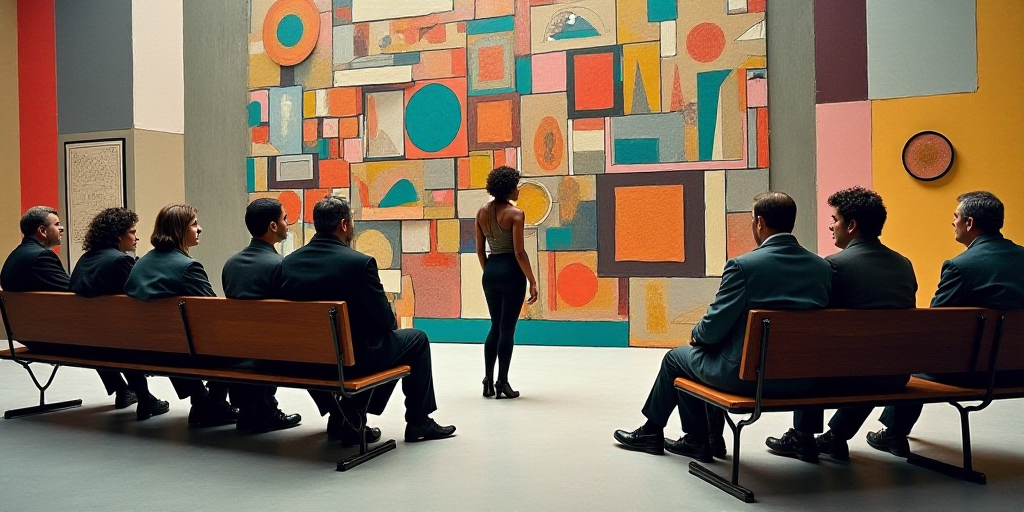As summer arrives, millions of people embark on discovering the cultural heritage of their cities or chosen vacation destinations. Visiting museums has become one of the most popular activities for those seeking a balance between relaxation, disconnection, and cultural enrichment.
What is Museum Fatigue?
Have you ever had to stop mid-visit to a museum due to an excessive fatigue that seems too much for the distance you’ve covered? After walking through three corridors and climbing two flights of stairs, the museum café suddenly seems more appealing than ancient Greek sculptures.
Hay mucho que ver en el Louvre…
Museum fatigue is precisely that – a physical and mental exhaustion experienced during museum visits. First described by Benjamin Ives Gilman, conservator of the Boston Museum of Fine Arts, in 1916, it marked the beginning of museum visitor studies. Gilman observed that visitors started their tours with enthusiasm but eventually lost interest, got distracted easily, or simply glanced over exhibits without paying attention.
This phenomenon results from a combination of factors: long walks, uncomfortable postures while observing artworks in cases or on walls, visual overstimulation, and information overload. These factors, along with summer heat and high tourist traffic, can make the museum experience more draining than enjoyable.
The Museum as an Active Space
Contrary to appearances, navigating a museum can be physically demanding, depending on one’s physical condition. A medium-sized museum visit may involve walking 1.5 to 3 kilometers.
If your goal is to see everything in a few hours at institutions like the Louvre Museum in Paris, the British Museum in London, or the Metropolitan Museum of Art in New York, you should start training for a half-marathon.
The issue isn’t just the extent of the route – which includes stairs, ramps, etc. – but also how we traverse it: constant stops, back-and-forth movements, and changing pace. Additionally, visitors spend much time standing, climbing, descending, and making repetitive movements like leaning, turning the neck, or maintaining focus for prolonged periods.
From a physical perspective, museum fatigue also has a mental component. The abundance of elements to focus on, wall texts, and crowded galleries can lead to mental and sensory overstimulation, affecting the visitor’s experience.
Suplemento cultural
Want to receive more articles like this? Subscribe to Suplemento Cultural and receive cultural news and a curated selection of the best articles on history, literature, film, art, or music, handpicked by our Culture Editor Claudia Lorenzo.
Setting this aside, visiting a museum can be seen as a light form of physical activity beneficial for everyone, especially older adults or those with mobility issues, provided it’s well-planned and excesses are avoided.
Tips to Avoid Museum Fatigue This Summer:
- Plan your visit: Before starting the tour or even before going to the museum, consult the map and select the exhibitions that interest you most. If you don’t know where to go upon arrival, adding decision-making stress will contribute to museum fatigue.
- Take frequent breaks: Utilize benches or rest areas to sit, hydrate, and process what you’ve seen. Some museums even offer short tours with strategic breaks.
- Choose the right time: If possible, visit early in the morning, at noon, or late in the afternoon when there’s less crowding and a more tranquil atmosphere.
- Wear comfortable clothing: Proper footwear and light clothing are essential for maintaining comfort throughout the visit, especially for that marathon you’re planning.
- Alternate activity and rest: Combine museum visits with outdoor activities or recreational ones that involve freer movement, like walking in a park or cycling around the city.
- Less is more: On vacation, the goal is to enjoy and not accumulate. A great experience in one museum is preferable to many rushed, exhausting visits.
- Don’t try to see everything: In line with the previous recommendation, attempting to view all exhibits in a museum is often impossible. Instead of focusing on every detail, try strolling through the space and stopping at what catches your eye. Remember, there’s no reward for reading every caption or seeing all the Picassos; your visit should be interesting and enjoyable for you.
A Shift in Perspective
Museums are also responding to this reality. When Gilman conducted his study in 1916, he took photographs of visitors showing the effort they had to exert to examine objects on display (kneeling, stretching, balancing, etc.). Today, museums are more visitor-focused and consider their experiences in designing exhibition spaces, known as museography.
Imágenes hechas por Gilman para su estudio en las que el visitante de museos tiene que adoptar diferentes (e incómodas) posturas.
Most museums now have designated rest areas and seating strategically placed, with exhibits displayed for comfortable viewing. Moreover, they offer short tours, mobile apps, guides, and even physical activities within the museum like yoga amidst sculptures or guided tours combining art and movement. The visitor is increasingly an active participant rather than a passive receiver of museum experiences.
In this context, the museum transforms from a passive contemplation space into one that promotes physical, mental, and emotional well-being, thus enhancing visitors’ overall well-being.
Understanding the Process
Visiting museums during vacations is an excellent way to learn, enjoy, and connect with culture. However, it’s also crucial to do so consciously, taking care of your body and respecting your pace.
Understanding museum fatigue as part of the process allows for a more enjoyable and deeper experience. Integrate movement and rest as allies of the aesthetic experience, as a profound and enjoyable journey or exhibition is not measured by what you see but by how deeply you live and enjoy it.
And if you still decide to run that Louvre half-marathon, we warned you… Start training now and good luck!






